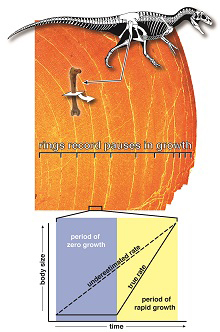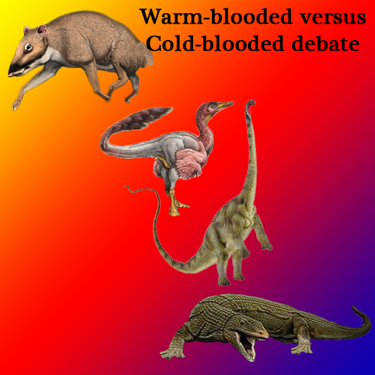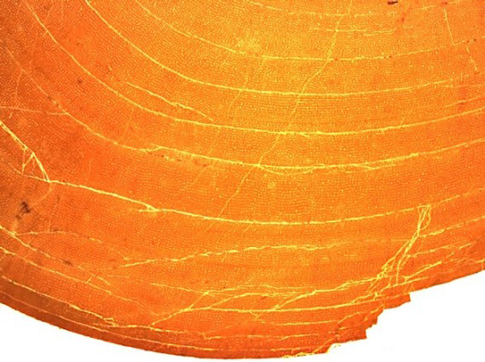Dinosaurs were Warm-blooded? Debate Hots Up
New Study Suggests Dinosaurs were Warm-blooded (Endothermic)
A scientist from Stony Brook University has reassessed a study into whether dinosaurs were cold or warm-blooded. Dr Michael D’Emic, a palaeontologist at the New York based university, has re-examined the research in a report published last summer which proposed that dinosaur metabolism was a kind of “half-way house” between a cold-blooded reptile and that of a warm-blooded mammal. Palaeontologist Dr D’Emic suggests that dinosaurs were not mesotherms (half-way between cold and warm-blooded), but instead their growth rates suggest that the Dinosauria are indistinguishable from the Mammalia in terms of their metabolism.
The Debate Over Dinosaur Metabolism Heats Up
Picture credit: Everything Dinosaur
Published a Technical Comment
Yesterday, (May 29th), Dr D’Emic’s study was published as a technical comment in the academic journal “Science” in response to the 2014 research. In the absence of a living, non-avian dinosaur to study, the debate boils down to interpretation of the evidence and statistical analysis. But why the fuss over what kind of metabolism the dinosaurs had?
Ectothermic versus Endothermic – It is Rather Important
We at Everything Dinosaur doubt very much that members of the public are going to be whopping and hollering about ectotherms (cold-blooded animals) or endotherms (warm-blooded) as they leave cinemas in a few weeks time having just watched “Jurassic World”, but understanding the metabolism of the Dinosauria is essential if scientists are really going to be able to learn how these animals lived and behaved. Let’s kick off with some simple explanations.
What does it mean to be Cold-blooded or Warm-blooded?
These terms are frequently used, but they are themselves a little misleading. These two distinct states do not define all vertebrates, things are a little more complicated than that, but in essence a creature that is regarded as cold-blooded relies on external sources to help regulate its body temperature. Typical examples are lizards and snakes basking in the sun to warm up in the morning, but then seeking much cooler shade to avoid over-heating in the middle of the day.
Warm-blooded animals (mammals and birds), are able to maintain a body temperature that is higher than the temperature of the environment. In simple terms, they can generate their own body heat. This heat comes from the animal’s metabolism, the chemical reactions that take place in the body (although there are other methods of keeping cool and warming up).
Applying this to the Dinosauria
If the dinosaurs had the same body chemistry as a crocodile (a reptile, regarded as an ectotherm), then they would have been relatively inactive compared to large mammals. Nocturnal activity could have been reduced along with geographical distribution, very cold environments would have been extremely hostile to cold-blooded dinosaurs. This is why today, we see the majority of reptile species confined to the tropics. If the dinosaurs had the same metabolism as birds and mammals, then they would have been much more active and not reliant on external sources to help maintain a body temperature that enabled them to function.
Body Chemistry
The type of body chemistry employed would impact on every aspect of their lives – migration, breeding, food intake, social interactions, growth rates, intra-specific and inter-specific competition and so forth.
Take food as an example. Whether herbivore, omnivore or carnivore, an ectotherm requires a lot less food in order to survive than an equivalent sized endotherm. Lions (warm-blooded), have to feed every three to five days on average. They have high metabolisms and high food demands as a result. Nile crocodiles that live in the same environment need much less food. One substantial meal can last a Nile crocodile several months, crocs are much less expensive to run. Sunlight can provide their bodies with all the heat they need, they don’t need to create it themselves, so their bodies need less food.
Dinosaurs were Warm-blooded
Over the years, team members at Everything Dinosaur have posted up articles on the ectotherm versus endotherm debate. In June 2014, we published a feature on the research carried out by student John Grady (University of New Mexico) in association with colleagues from the University of Arizona and the Sante Fe Institute. It is the results of this research that Dr D’Emic has reassessed.
To read about the June 2014 study: Goldilocks and Dinosaurs – The Warm-blooded/Cold-blooded Debate.
Dr D’Emic proposes that further analysis of microscopic growth rings preserved in dinosaur fossil bone, suggests that dinosaurs grew as quickly as mammals. This suggests fast metabolisms and therefore that the Dinosauria were endothermic. The earlier study had undertaken a detailed analysis on the growth rates of a wide variety of extinct and extant organisms. The research team led by John Grady concluded that dinosaurs were mostly like mesotherms.
Dr D’Emic stated:
“Upon re-analysis, it was apparent that dinosaurs weren’t just somewhat like living mammals in their physiology – they fit right within our understanding of what it means to be a “warm-blooded” mammal.”
Examining Bone Structure
As a Research Instructor in the Dept. of Anatomical Sciences, Dr D’Emic specialises in the study of the structure of bone. Using microscopic slices of fossil bone that has been carefully cut and polished, the doctor read growth rings preserved in the bone just as a dendrochronologist examines tree rings. He looked at the 2014 study from two specific view points, firstly the research had scaled down yearly growth rates to daily ones in order to standardise the data.
Commenting on this aspect of the earlier study, he explained:
“This is problematic, because many animals do not grow continuously throughout the year, generally slowing or pausing growth during colder, drier, or otherwise more stressful seasons.”
He concluded that the 2014 study may have underestimated the growth rate of the different types of dinosaur included in the dataset, by failing to account for their uneven growth. Like many extant animals, dinosaurs slowed or paused their growth. This is marked by the growth rings that can be made out in micro-anatomical bone studies. The doctor added that growth rates were especially underestimated for larger animals and animals that live in very stressful or seasonal environments – both of which characterise the Dinosauria.
Microscopic studies of Dinosaur Bone Reveal Growth Rings
Picture credit: Stony Brook University
Secondly, in the paper entitled “Evidence for Mesothermy in Dinosaurs”, birds in the sample studied were treated separately from the twenty-one dinosaurs that were included, In this reassessment, birds and dinosaur data was included as one homogeneous group. Birds are warm-blooded and they are direct descendants of dromaeosaur dinosaurs.
The doctor explained:
“Separating what we commonly think of as “dinosaurs” from birds in a statistical analysis is generally inappropriate, because birds are dinosaurs – they’re just the dinosaurs that haven’t gone extinct.”
Were Dinosaurs Mesotherms?
Under these new conditions for examining the statistics, the birds being included in the dinosaur assessment data, lends more weight to the idea that the Dinosauria were endothermic and not the “half-way house” as mesotherms.
It seems that as with virtually all studies of this nature, the way that the data is handled and the terms of reference will influence the conclusions that can be drawn.
Microscopic Analysis of Fossilised Bones Helps Identify Growth Patterns

A microscopic image of the thigh bone (femur) of a dinosaur shows concentric rings. The rings represent unrecorded time, so an annual growth rate (dashed line in graph) is an underestimate relative to the true growth rate during the favourable growing season.
Picture credit: Scott Hartman
Comments regarding this new assessment of the earlier research have already been made. For example, the team behind the 2014 study have responded to this analysis by commenting that the new study raises a number of important statistical and methodological questions, however, the proposals made lack biological and statistical justification.
All scientists who step bravely into this area of academic endeavour deserve our admiration, both papers are part of the rich and extremely diverse range of research that has gone into tackling this very thorny problem, it seems that the warm-blooded versus cold-blooded debate is likely to rumble on.



